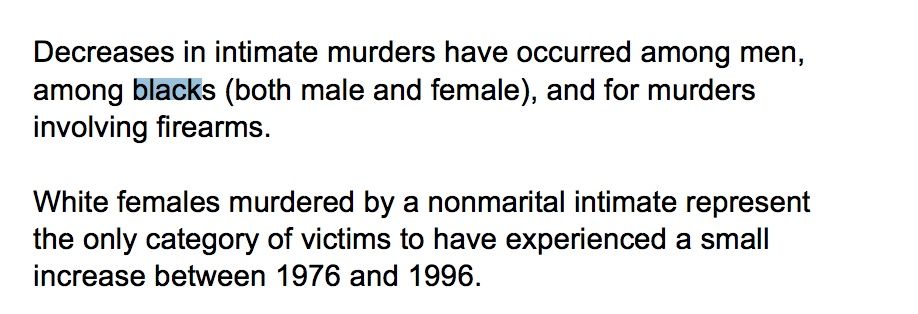Indiglow Meta (R$G)
Ultra.
https://bjs.gov/content/pub/pdf/vi.pdf
Page 5: Female murder victims are substantially more likely than male murder victims to have been killed by an intimate. From 1976-96, 18.9% of women victims were murdered by husbands, 1.4% by ex-husbands, and 9.4.% by non marital partners. Over the same period, 3.7% of male victims were killed by wives,0.2% by ex-wives, and 2.0% by non marital partners
Page 6: Intimate murders accounted for 30% of all female murders and 6% of all male murders. the 32,580 spouses who were murder victims between 1976 and 1996, about 6 in 10 were women.
More important:
Let's evaluate this much toted quote supposedly proving black women violence:
Page 8: Between 1976 and 1989 more black men were killed by their wives than black women were killed by their husbands.
No one seems to quote the rest of that paragraph of:After 1990 the order was reversed, and the murder rate among black wives and ex-wives was higher than that among black husbands and ex-husbands.
Also page 8: The decline in the rate of intimate murder among black husbands/ex-husbands has been greater than for any other category of intimate murder victims.
Also, the study shows some drastic number changes
Page 7 : In 1976 the per capita rate of intimate murders among blacks was nearly 11 times that among whites; But in 1996 the black rate was just over 4 times higher than the white rate.
also
In 1976 the per capita rate of intimate murder of black men was nearly 19 times higher than that of white men. The rate among black females that year was 7 times higher than the rate among white females. In 1996 the black male rate was 8 times that of white males, and the black female rate was 3 times higher than the white female rate.
Page vii: The National Crime Victimization Survey (NCVS), which gathers data on criminal victimization from a national sample was started in 1972. But in the late 80's (86 on) the Bureau of Justice Statistics (BJS), sought to improve the NCVS components to enhance the measurement of crimes including rape,sexual assault, and intimate and family violence. A new questionnaire was created and it was phased in from January 1992 through June 1993. This new questionnaire provided a higher estimated counts of incidents of intimate violence than the old questionnaire
Data on their own without proper interpretation is useless.
He emphasized that part to show that black women are complicit in domestic violence acts, PERIOD.
It's part of a cycle of violence. You are not part of that community.
Is the per capita rate of black males being violent toward black men equal or greater to white men? NO?
You took that long for this? This was your "coup de grace"? You gave us NOTHING.




